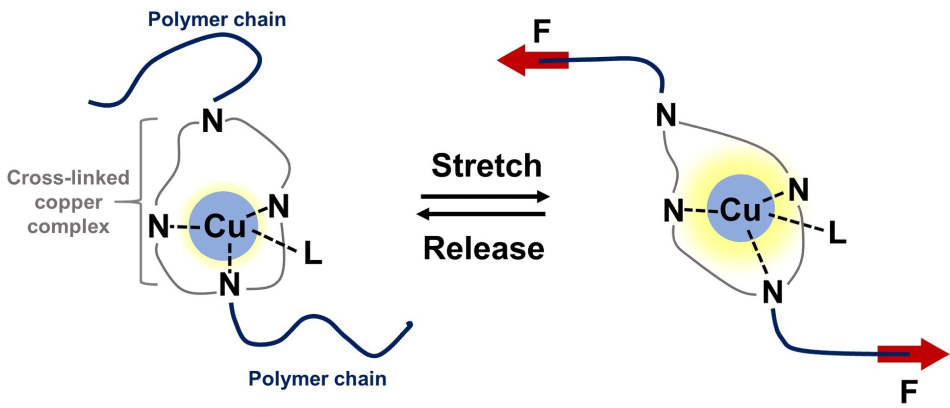Jan 24 2020
An innovative stress-detecting “smart” polymer has been recently developed by researchers at the Okinawa Institute of Science and Technology Graduate University (OIST). This unique polymer glows brighter upon stretching.
 The copper mechanophore links two polymer chains together. When the polymer is stretched (force = F), the mechanophore glows brighter. Image Credit: Okinawa Institute of Science and Technology Graduate University.
The copper mechanophore links two polymer chains together. When the polymer is stretched (force = F), the mechanophore glows brighter. Image Credit: Okinawa Institute of Science and Technology Graduate University.
Scientists are hoping to utilize this novel polymer to monitor the wear and tear experienced by materials employed in the engineering and construction sectors and quantify the performance of synthetic polymers.
To develop this polymer, the researchers integrated copper complexes into a polymer known as polybutylacrylate. Copper complexes are structures that are formed by joining copper atoms to organic molecules that contain carbon, while polybutylacrylate is produced from a chemical used for producing sealants, adhesives, and acrylic paints.
Joining the polybutylacrylate chains together, the copper complexes naturally shine upon exposure to ultraviolet light. This property is referred to as photoluminescence.
However, the copper complexes produce a higher intensity of light upon stretching the polymer, thereby resulting in a brighter glow. Hence, these copper complexes behave as mechanophores—that is, compounds which experience a change upon stimulation by a mechanical force.
A majority of the mechanophores are made from organic compounds, and not from metals like copper. When a weak chemical bond is broken down by mechanical stress, these organic compounds produce light or change their color. However, mechanophores using this bond-breaking mechanism have considerable restrictions.
A relatively large force is required to break the chemical bond, so the mechanophore is not sensitive to small amounts of stress. Also, the process of breaking the bond is often irreversible and so these stress sensors can only be used once.
Dr Ayumu Karimata, Postdoctoral Scholar, Coordination Chemistry and Catalysis Unit, Okinawa Institute of Science and Technology Graduate University
Karimata is also the study’s first author. The Coordination Chemistry and Catalysis (CCC) Unit is headed by Professor Julia Khusnutdinova.
On the other hand, the novel copper mechanophores created by the CCC unit are responsive to relatively smaller stresses and can react reversibly and rapidly.
In the research published in the Chemical Communications journal, the researchers demonstrated that the polymer film glows and dims quickly upon stretching and releasing.
Shining a Light on the Mechanism
These copper complexes are one such example of photoluminescent compounds that had attracted the interest of the CCC unit for a long time. Before developing the polymer, the scientists produced isolated copper complexes that had different sizes.
The researchers discovered that the copper complexes were highly dynamic and therefore constantly distorted in shape. However, as their size increased, the copper complexes glowed brighter and turned out to be less flexible.
According to the CCC unit, the less flexible and larger copper complexes emit light more efficiently due to their limited motion, and hence, they lose low amounts of energy in the form of heat.
The scientists discovered that the association between the brightness of the copper complexes and flexibility can be manipulated to produce a stress-sensing polymer.
When the copper complexes are incorporated into the polymer as cross-links, the act of stretching the polymer also reduces the flexibility of the molecules. This causes the copper complexes to luminesce more efficiently with greater intensity.
Dr Ayumu Karimata, Postdoctoral Scholar, Coordination Chemistry and Catalysis Unit, Okinawa Institute of Science and Technology Graduate University
While it is still a long way to go, Dr Karimata believes that the acrylic polymer could be ultimately adjusted to synthesize stress-detecting acrylic paints. This can potentially have useful applications as a coating for a variety of structures, for example, the frames of aircraft and cars or bridges.
As we can see even from the direct visualization of the polymer, stress is applied across a material in a non-uniform way. A stress-sensing paint would allow hotspots of stress on a material to be detected and could help prevent a structure from failing.
Dr Ayumu Karimata, Postdoctoral Scholar, Coordination Chemistry and Catalysis Unit, Okinawa Institute of Science and Technology Graduate University
Video of polymer being stretched and released
The scientists used a CCD camera to directly visualize the changes in brightness as the polymer was stretched and released. The false color red represents high light intensity and the false color blue represents low light intensity. Video Credit: Coordination Chemistry and Catalysis Unit, Okinawa Institute of Science and Technology Graduate University.